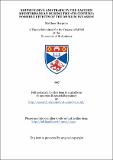Files in this item
Shipbuilding and trade in the Eastern Mediterranean during the 7th century : possible effects of the Muslim invasion
Item metadata
| dc.contributor.advisor | Martin, Colin | |
| dc.contributor.advisor | Prescott, Robert | |
| dc.contributor.author | Harpster, Matthew | |
| dc.coverage.spatial | 100 p. | en_US |
| dc.date.accessioned | 2018-06-25T14:05:49Z | |
| dc.date.available | 2018-06-25T14:05:49Z | |
| dc.date.issued | 1997-06 | |
| dc.identifier.uri | https://hdl.handle.net/10023/14547 | |
| dc.description.abstract | This thesis examines the change in shipbuilding techniques from the mortice and tenon method common in antiquity, to the frame first method, specifically when the former method disappeared, in the 7th century AD. It approaches this change, which is documented in the archaeological record, from a historical point of view, creating a context around the archaeological material, a context which was previously missing. As it does so, it arrives at the conclusion that the Muslim invasion brought a new economic and political atmosphere to the eastern Mediterranean which, in contrast to the Byzantine Empire, was conducive to an expansion in independent mercantilism and a change in shipbuilding techniques. | en_US |
| dc.language.iso | en | en_US |
| dc.publisher | University of St Andrews | |
| dc.subject.lcc | HF381.H2 | en |
| dc.subject.lcsh | Mediterranean Region--Commerce--History | en |
| dc.title | Shipbuilding and trade in the Eastern Mediterranean during the 7th century : possible effects of the Muslim invasion | en_US |
| dc.type | Thesis | en_US |
| dc.type.qualificationlevel | Masters | en_US |
| dc.type.qualificationname | MPhil Master of Philosophy | en_US |
| dc.publisher.institution | The University of St Andrews | en_US |
This item appears in the following Collection(s)
Items in the St Andrews Research Repository are protected by copyright, with all rights reserved, unless otherwise indicated.

